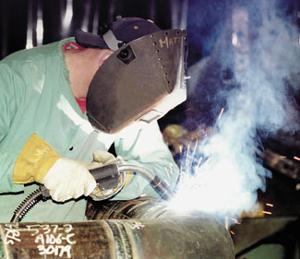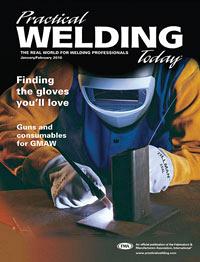Contributing Writer
- FMA
- The Fabricator
- FABTECH
- Canadian Metalworking
Categories
- Additive Manufacturing
- Aluminum Welding
- Arc Welding
- Assembly and Joining
- Automation and Robotics
- Bending and Forming
- Consumables
- Cutting and Weld Prep
- Electric Vehicles
- En Español
- Finishing
- Hydroforming
- Laser Cutting
- Laser Welding
- Machining
- Manufacturing Software
- Materials Handling
- Metals/Materials
- Oxyfuel Cutting
- Plasma Cutting
- Power Tools
- Punching and Other Holemaking
- Roll Forming
- Safety
- Sawing
- Shearing
- Shop Management
- Testing and Measuring
- Tube and Pipe Fabrication
- Tube and Pipe Production
- Waterjet Cutting
Industry Directory
Webcasts
Podcasts
FAB 40
Advertise
Subscribe
Account Login
Search
Welding specialty metals safely
Taking a three-tiered approach to safety
- By Karen D. Hamel
- October 11, 2001
- Article
- Safety
Welders spend a lot of time acquiring the skills to work with a variety of metals to create flawless welds, but they might not learn about the less obvious safety hazards associated with the materials they work with.
Welders in power, food processing, and pharmaceutical plants often use special high-alloy steels, stainless steels, and high-nickel alloys. These materials can contain hazardous elements such as chromium, nickel, manganese, and cobalt. Additionally, plated or finished metals can contain zinc, cadmium, arsenic, lead, and copper. While each of these components has specific metallurgical advantages, their use also requires an understanding of toxic gases that are generated when they are welded.
Study Focuses on Danger of Welding Fumes
A recent study conducted by the Engineering Control Technology Branch of the National Institute for Occupational Safety and Health (NIOSH) at the Boilermaker's National Apprenticeship Training School in Kansas City, Kan., found that fumes produced by welding stainless steels contain a variety of toxic constituents. The study focused on the types of fumes generated and the effectiveness of fume-abatement equipment to protect welders.
The analysis showed that welding stainless steel exposes workers to arsenic, nickel, chromium, hexavalent chromium, manganese, and iron. NIOSH considers arsenic, hexavalent chromium, nickel, and cadmium to be likely carcinogens.
Further, case studies link excessive exposure to welding emissions with a high incidence of acute and chronic respiratory ailments.Workers who do not wear proper respiratory devices can put themselves at risk for a variety of health problems. According to the study, "Welder respiratory ailments can include occupational asthma, chronic bronchitis, fibrosis of the lung, and lung cancer."
Under the Occupational Safety and Health Administration's (OSHA's) hazard communication standard, employers are responsible for identifying and informing workers of hazards they face in the workplace. Furthermore, OSHA requires employers to train workers about hazards they may be exposed to and provide them with proper protection and safeguards.
Therefore, welders, as well as their supervisors, must learn about the nature of hazardous fumes created during the welding process. This education goes beyond training and should include an accurate description of the materials they work with. If welders work with a variety of metals, they should receive specific instructions for each type of metal.
Three-tiered Approach
One of the best approaches to safety in any workplace is a three-tiered method in which you:
- Eliminate the hazard, if possible.
- Contain, reduce exposure to, or render the hazard harmless.
- Provide the worker with protective devices.
Welding fumes from stainless steels and other exotic metals cannot be eliminated, so a combination of the second and third tiers may be the best approach.
At the second tier, certain methods can render the fumes harmless to protect the welder. If the welding is performed inside a shop, a local or workstation-specific exhaust system can evacuate the fumes from the work site. The evacuation system's capacity must be sufficient to remove welding fumes from the vicinity of the welder and maintain toxic fume concentration below the lower threshold limits (LTL) of the contaminants.
Using exhaust systems also means that outside air is needed to replenish the exhausted air, a primary concern in cold weather. Additionally, the fume collection equipment must be close to the source of the welding fumes to be effective in mitigating the hazard. The system should conform to OSHA requirements and be consistent with NIOSH methodology. Also, it is important to remember that one analytical test of the fume evacuation system is worth a thousand expert opinions.
Outside welding is more complex. Fume collection systems are at the mercy of the weather. Temperature, humidity, and wind can render them ineffective. The physical position of the welder, which often depends on the particular job, is another contributing factor to the fume collection system's effectiveness.
Also, the type of welding performed affects exposure levels. Overhead welding subjects welders to a lesser volume of toxins than welding in a flat position. Fume concentrations from vertical welds can be somewhere in-between.
Often the most practical approach is to blow the fumes away from the welder by directing a flow of air in front of the welder with a fan or blower. A lightweight, compressed air-powered horn that creates vacuum pressure can dissipate fumes. Care should be taken to direct the flow of air between the worker and the equipment—not between the equipment and the piece being welded —so that shielding gases used will not be displaced with the fumes.
The third tier—wearing protective devices—may be the best approach when other methods cannot ensure adequate protection. Depending on the toxicity and volume of the welding fumes, welders can wear properly rated air purifying respirators under welding masks, or masks can be fitted with an integral clean air supply that continuously provides the welder with a fresh, uncontaminated source of air.
Reference:
U.S. Department of Health and Human Services, Report No. ECTB 214-13a, "In Depth Survey Report: Control Technology Assessment for the Welding Operations at Boilermakers' National Apprenticeship Training School," Kansas City, Kan.
About the Author
About the Publication
subscribe now

The Welder, formerly known as Practical Welding Today, is a showcase of the real people who make the products we use and work with every day. This magazine has served the welding community in North America well for more than 20 years.
start your free subscription- Stay connected from anywhere

Easily access valuable industry resources now with full access to the digital edition of The Fabricator.

Easily access valuable industry resources now with full access to the digital edition of The Welder.

Easily access valuable industry resources now with full access to the digital edition of The Tube and Pipe Journal.
- Podcasting
- Podcast:
- The Fabricator Podcast
- Published:
- 04/16/2024
- Running Time:
- 63:29
In this episode of The Fabricator Podcast, Caleb Chamberlain, co-founder and CEO of OSH Cut, discusses his company’s...
- Industry Events
16th Annual Safety Conference
- April 30 - May 1, 2024
- Elgin,
Pipe and Tube Conference
- May 21 - 22, 2024
- Omaha, NE
World-Class Roll Forming Workshop
- June 5 - 6, 2024
- Louisville, KY
Advanced Laser Application Workshop
- June 25 - 27, 2024
- Novi, MI
































